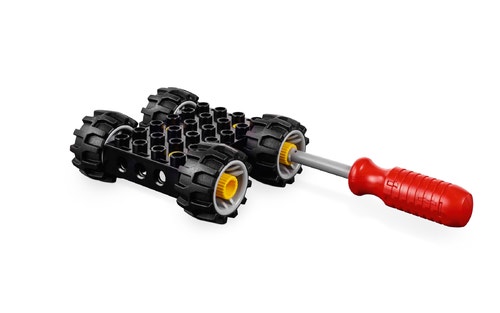Heavy Load!
The objective of this lesson is for children to explore weight, compare objects and use comparative language.

Connect
Pick two objects from around the classroom, one heavy and one light, to illustrate a difference in weight.
Ask the children to compare the two objects.
Ask questions like:
- Which of these is heavier?
- Explain that the heavier object weighs more than the lighter object.
- Which is lighter?
Explain that the lighter object weighs less than the heavier object.
Tell the children that lifting heavy objects is a common challenge that people face.
Explain that one way people transport heavy objects is by using special heavy-duty trucks.

Construct
Ask the children to build their very own heavy-duty truck to haul a heavy load.
Explain that they may use the building cards for inspiration or design their own truck.
Remind the children that their truck should include a place to load heavy objects.
As the children build, help them use the screwdriver to secure their wheels.
Once the children have finished building, ask them to test their heavy-duty trucks using objects from around the classroom.
Encourage the children to load up their trucks and haul the load across the room!
Contemplate
Facilitate a discussion about the children’s trucks.
Ask questions like:
- Why was your truck able (or not) to move the heavy load?
- What other machines might have been able to move the same load?
Talk about how lifting heavy objects can be dangerous. Discuss how workers should always use their trucks in a safe manner.
Continue
Explain that other types of vehicles and machines can transport heavy items.
Give a few examples, like cranes which use pulleys to lift heavy objects.
Ask the children to design and build another machine or vehicle to transport their heavy load.
Encourage them to test their new designs and demonstrate how to safely load and unload their new machine or vehicle.
Did you notice?
Observing the following skills can help you monitor whether the children are developing the necessary competencies:
- Technology - Asking questions about science-related concepts, specifically weight
- Engineering - Participating in the engineering process by designing, building, and testing models
- Engineering - Understanding and demonstrating how machines help people to solve problems and accomplish tasks
- Math - Comparing two or more objects or attributes
Teacher Support
Children will:
- Explore the components of the Tech Machines set
- Explore weight and compare objects
- Use comparative language
- Design a vehicle to help with a task, and demonstrate how it works
For up to 4 children
Tech Machines set (45002)
A heavy object and a light object from around the classroom
Additional objects that fit into the truck models
The learning guidelines from the National Association for the Education of Young Children (NAEYC), Head Start, and the Next Generation Science Standards (NGSS) have been used to develop the Tech Machines lessons. This Teacher Guide focuses on the learning values for math, science, and engineering. Please refer to the learning grid for an overview of the learning values referenced throughout the lessons. The learning goals listed at the end of each lesson can be used to determine whether each child is developing the relevant skills. These bullet points target specific skills or pieces of information that are practiced or presented during each lesson.




